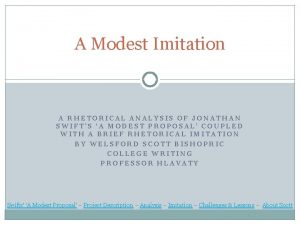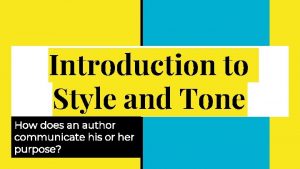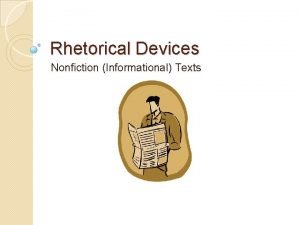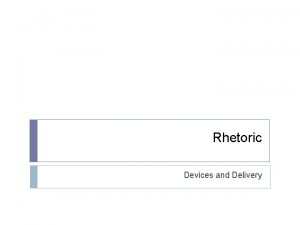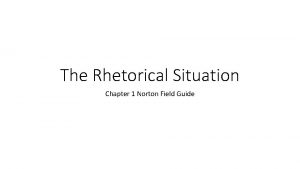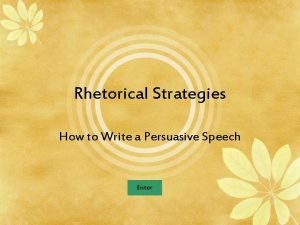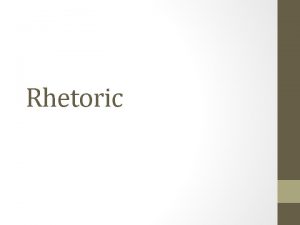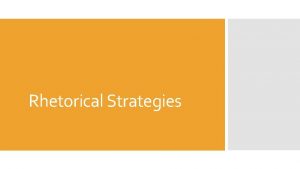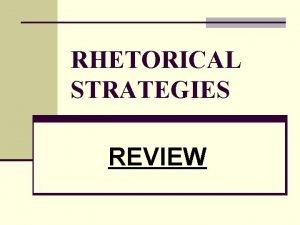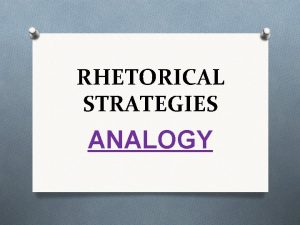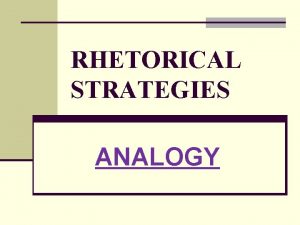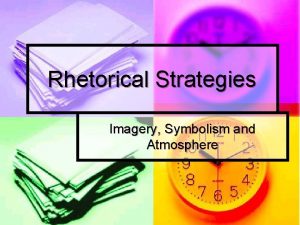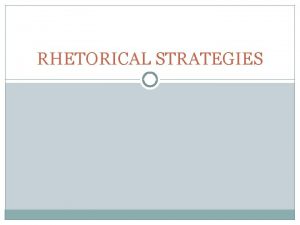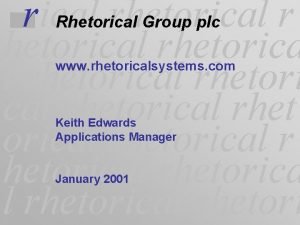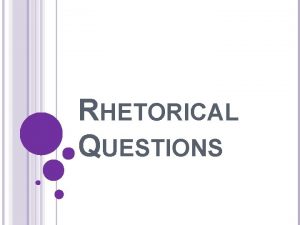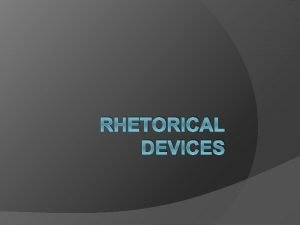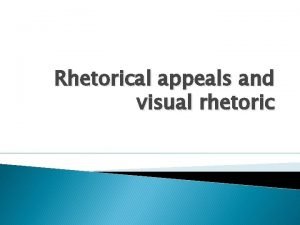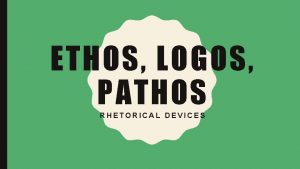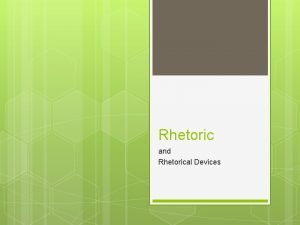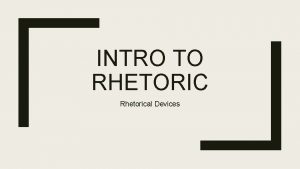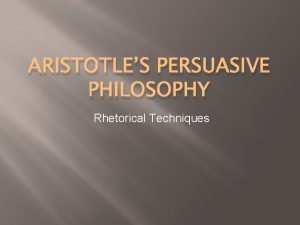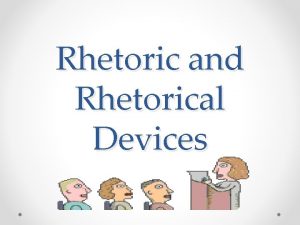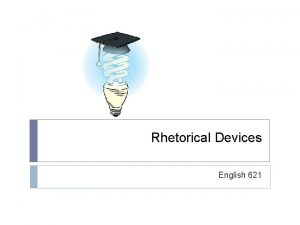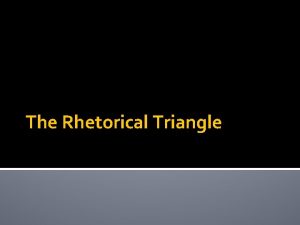Rhetorical Strategies What is rhetoric Rhetoric is the































- Slides: 31

Rhetorical Strategies What is rhetoric? Rhetoric is the art of persuasive speaking or writing ¡ Having excellent rhetoric can help you win the argument ¡

Alliteration The close repetition of consonant sounds, usually at the beginnings of words ¡ Examples: Best Buy, Captain Kid, Dynamic Duo, Phil the Fish ¡

Allusion ¡ ¡ ¡ A reference to a person, object, or event from the Bible, mythology, literature, or popular culture Example: If you tell him that, you are opening up Pandora’s box. Example: They thought they were Romeo and Juliet.

Antithesis ¡ ¡ A technique of putting two opposite ideas near each other in a sentence to create a powerful effect Example: “It was the best of times, it was the worst of times. ” (Charles Dickens) Example: “We are caught in war, wanting peace. ” (Richard Nixon) Example: “Ask not what your country can do for you–ask what you can do for your country. ” (JFK)

Metaphor ¡ ¡ ¡ Short comparison of the characteristics of two unlike things, without using “like” or “as. ” Example: “The moon was a golden grapefruit high up in the sky. ” The moon is being compared to a grapefruit.

Simile ¡ ¡ Short comparison of the characteristics of two unlike things, using “like” or “as. ” Example: “Our ignorance is like a vast sea, deep and wide. ”

Metaphor vs. Simile ¡ ¡ Metaphor: This bread is a rock. Simile: This bread is like a rock. Simile: This bread is as hard as a rock. Tip: The word “simile” has an “l” and an “s. ” Think “l” for like and “s” for as.

Parallel Structure Creating balance in a sentence by using the same grammatical pattern ¡ Example: “Less measurable but no less profound” – (Barack Obama) ¡ Example: “from every village and every hamlet, from every state and every city” – (MLK, Jr. ) ¡

Refrain ¡ ¡ Repeating a word, phrase, or sentence throughout a speech to create some kind of rhythm. Example: “Twinkle, twinkle, little star” is repeated many times throughout the song.

Rhetorical Questions These questions are used for effect and are not to be answered. It is to draw the audience’s attention to a specific area. ¡ Example: “What is the legacy we are leaving for our future generations when we abuse the earth? ” ¡

How to Conduct Research ¡ ¡ Not all information over the internet is considered legitimate. To determine the validity of a web source, you must ask yourself several questions.

Consider these types of sources ¡ ¡ ¡ Major newspapers (www. latimes. com, www. nytimes. com) Major magazines (www. newsweek. com, www. time. com, www. usnews. com, www. nationalgeographic. com, www. economist. com) Major broadcast media (www. abcnews. com, www. cnn. com)

More Sources ¡ ¡ Government organizations (www. epa. gov, sites that end with. gov) Educational institutions (www. ucla. edu) Health & medical websites (kidshealth. org, www. mayoclinic. com, www. nih. gov, www. webmd. com) Non-profit foundations (www. lungcancer. org, www. americanheart. org, http: //ww 5. komen. org)

NOT acceptable sources ¡ ¡ Special interest websites Blogs Websites published by one person or a group of people (The information provided on these sites are not first-hand facts. These individuals do not conduct research, and they did not collect the data first-hand. ) These do not pass the test of objectivity or authority as stated by Cornell University

Important Make sure you read the “About Us” link of any website you visit. That will be the first step in determining whether the source is appropriate.

Five criteria for evaluating Web pages by Olin and Uris Libraries Cornell University http: //www. library. cornell. edu/olinuris/ref/re search/evaluate. html

Accuracy of Web Documents Who wrote the page and can you contact him or her? ¡ What is the purpose of the document and why was it produced? ¡ Is this person qualified to write this document? ¡

Authority of Web Documents Who published the document and is it separate from the "Webmaster"? ¡ Check the domain of the document; what institution publishes this document? ¡ Does the publisher list his or her qualifications? ¡

Objectivity of Web Documents What goals/objectives does this page meet? ¡ How detailed is the information? ¡ What opinions (if any) are expressed by the author? ¡

Currency of Web Documents When was it produced? ¡ When was it updated? ¡ How up-to-date are the links (if any)? ¡

Coverage of the Web Documents Are the links (if any) evaluated and do they complement the documents' theme? ¡ Is it all images or a balance of text and images? ¡ Is the information presented cited correctly? ¡

Writing your speech Format • Introduction • Body • Conclusion Use rhetorical strategies to dazzle your audience!

Introduction ¡ ¡ Purpose is to grab the audience’s attention Use a hook l l l General statement about life Rhetorical question Statistical fact (i. e. CO 2 levels highest in one million years) Quote from a well-respected famous person An anecdote (see next slide)

Using an Anecdote in the Introduction Tell a brief story ¡ One that introduces your topic ¡ Real story (proper identification) ¡ Make up a scenario (create a mental image) ¡

Starting with an Anecdote Imagine a mountain of gleaming plastic bottles. Imagine a lake without water. This could be our future tomorrow, if we don’t make a change today. Our world is headed for an ecological disaster, unless we take drastic steps to change our inheritance.

Lake Mead

Thesis: Two Ways ¡ Version 1: l ¡ Although teenagers don’t like dress codes and school uniforms, having expectations about school attire improves student behavior, saves money, and reduces clothes competition. Then, you write a paragraph about improving student behavior, saving money, and reducing clothing competition.

Thesis: Two Ways ¡ Version 2: l ¡ Although teenagers don’t like dress codes and school uniforms, having expectations about school clothing solves many problems in the end. Less specific and leaves you open to write more.

Body of the Speech Include arguments for your side ¡ Include evidence, facts, statistics, quotes (Concrete Details) ¡ “We hold these truths to be selfevident, that all men are created equal…that among these are Life, Liberty and the pursuit of Happiness. ” The Declaration of Independence

Purpose of the Conclusion Drive home your argument ¡ Summarize your speech ¡ Provide closure ¡ Leave the audience thinking ¡

How to Conclude Visualization – create a mental picture (show, don’t tell) ¡ Refer back to your opening statements ¡ Ask a rhetorical question ¡ Call to action – get the audience to act ¡
 Inclusive language rhetorical device
Inclusive language rhetorical device A modest proposal rhetorical analysis
A modest proposal rhetorical analysis Syllepsis example
Syllepsis example Rhetorical tools
Rhetorical tools Rhetorical strategy
Rhetorical strategy Rhetorical strategies list
Rhetorical strategies list Norton rhetorical strategies
Norton rhetorical strategies Rhetorical strategies
Rhetorical strategies Logos ethos oathos
Logos ethos oathos Public statement by eight alabama clergymen
Public statement by eight alabama clergymen Bổ thể
Bổ thể Vẽ hình chiếu đứng bằng cạnh của vật thể
Vẽ hình chiếu đứng bằng cạnh của vật thể Phản ứng thế ankan
Phản ứng thế ankan Các môn thể thao bắt đầu bằng tiếng bóng
Các môn thể thao bắt đầu bằng tiếng bóng Khi nào hổ mẹ dạy hổ con săn mồi
Khi nào hổ mẹ dạy hổ con săn mồi điện thế nghỉ
điện thế nghỉ Một số thể thơ truyền thống
Một số thể thơ truyền thống Nguyên nhân của sự mỏi cơ sinh 8
Nguyên nhân của sự mỏi cơ sinh 8 Trời xanh đây là của chúng ta thể thơ
Trời xanh đây là của chúng ta thể thơ Bảng số nguyên tố lớn hơn 1000
Bảng số nguyên tố lớn hơn 1000 Thiếu nhi thế giới liên hoan
Thiếu nhi thế giới liên hoan Tỉ lệ cơ thể trẻ em
Tỉ lệ cơ thể trẻ em Vẽ hình chiếu vuông góc của vật thể sau
Vẽ hình chiếu vuông góc của vật thể sau Các châu lục và đại dương trên thế giới
Các châu lục và đại dương trên thế giới Thế nào là hệ số cao nhất
Thế nào là hệ số cao nhất Sơ đồ cơ thể người
Sơ đồ cơ thể người Tư thế ngồi viết
Tư thế ngồi viết Hình ảnh bộ gõ cơ thể búng tay
Hình ảnh bộ gõ cơ thể búng tay đặc điểm cơ thể của người tối cổ
đặc điểm cơ thể của người tối cổ Bàn tay mà dây bẩn
Bàn tay mà dây bẩn Cách giải mật thư tọa độ
Cách giải mật thư tọa độ Tư thế worms-breton
Tư thế worms-breton

